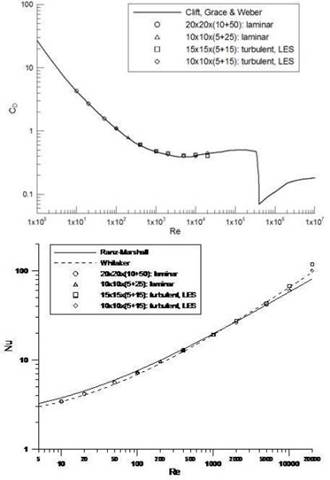
ACS PRF | ACS
All e-Annual Reports

43706-AC9
Connecting Catalytic Chemistry to External Particle Conditions via Computational Fluid Dynamics
The objective of this project is the more realistic treatment of catalyst particle internal transport and reaction processes by linking them to conditions in the fluid flowing past and surrounding the particle. The work is divided into two main tasks: 1) development and testing of a computational fluid dynamics (CFD) approach to coupling intraparticle chemistry and species transport to the external flow field; 2) evaluation of the behavior of catalyst particles near the wall of a steam reformer reactor tube, and the development of improved models for them.
Our original proposal for including porous particles in the CFD simulations, using Fluent commercial code, was to treat them as solid regions and write our own user-defined code with user-defined scalars to couple the solid regions with no chemical species to the fluid regions with chemical species. We quickly saw that this would be very time-consuming, and were able to devise a different approach, in which we defined the particles as porous regions, with modified properties and mesh structure that allowed them to mimic solid particles. This allowed good progress on the main objectives of the work.
We have conducted mesh development and refinement studies for isothermal flow past single spheres and full cylinders. We have validated flow around constant-wall-temperature solid spheres by calculating drag coefficient CD and particle Nusselt number Nu and obtaining excellent comparison to literature correlations of experimental data, as shown in the figure below. We found that at the flow rates of interest for steam reforming, packed tubes are in an unsteady turbulent flow regime and accurate values of CD require unsteady simulations by Large Eddy Simulation (LES). Simulations with the steady k-ω SST method gave reasonable time-averaged values for Nu and may be used to give steady-state average particle performance.
In the second task of the project, an evaluation study was carried out of the standard pseudo-continuum (P-C) packed bed model, using results from the discrete packing CFD simulations. Different correlations were utilized in order to express the velocity, thermal conductivity, bed voidage, and diffusion coefficients in the P-C models either in the form of flat profiles (constant values) or in the form of functions of the radial tube position. We used parameter values and correlations from the most-quoted sources in the literature, but it was observed that the flat or correlation-based effective parameter profiles were not enough to express the features of the simulated particles in terms of heat uptakes, tube wall temperatures, species conversions, and radial temperature and species profiles. To create the most favorable case for the pseudo-continuum model, we even obtained the fitted parameters for the velocity, effective diffusivity and radial thermal conductivity profiles from the CFD simulations and used them in the pseudo-continuum model. It was seen that the temperature profiles were very much affected by the velocity and thermal conductivity definitions. On the other hand, species profiles were significantly influenced by properly defined effective diffusivity profiles. Nevertheless, similar results were obtained to the previous stage. Our final conclusion is that the conventional pseudo-continuum models cannot fully reproduce the CFD simulation results due to the complex interplay of internal and external transport and reaction which cannot be represented by the simplified pseudo-continuum models no matter which transport parameter values or correlations are incorporated. This finding provides the basis for the second part of task 2, in which we will work on developing different models to represent catalyst particles in strong near-wall temperature gradients. The funding provided by this ACS/PRF grant has allowed graduate student Ertan Taskin to complete his Ph.D., which was successfully defended this August. We have also introduced two undergraduate students to research, in the summer following their sophomore year. The funding has allowed the PI to develop the more chemistry-based aspects of the CFD research effort, which promises well for future applications.  During the summer of 2007, we were able to use some of the funds originally intended for graduate student tuition, to support two undergraduates to learn CFD and initiate two subprojects. In one, the students developed meshes for complex particle shapes with multiple holes, which are typical of commercial steam reforming catalysts, and conducted flow simulations around single particles yawed at different angles. This work allows us to evaluate the surface accessibility to flow, and thus reactants, of internal voids, and how this depends on angle of attack. This work will give valuable insight to preferred packing techniques. We will continue with it during the upcoming year, as more needs to be done on validation against literature studies of flow around yawed cylinders. In the second sub-project, the students repeated previous simulations, but used temperature-dependent physical properties. Initial results suggest that under steam reforming conditions there is little effect of temperature-dependence, but this, too, needs further work to polish and validate the results.
During the summer of 2007, we were able to use some of the funds originally intended for graduate student tuition, to support two undergraduates to learn CFD and initiate two subprojects. In one, the students developed meshes for complex particle shapes with multiple holes, which are typical of commercial steam reforming catalysts, and conducted flow simulations around single particles yawed at different angles. This work allows us to evaluate the surface accessibility to flow, and thus reactants, of internal voids, and how this depends on angle of attack. This work will give valuable insight to preferred packing techniques. We will continue with it during the upcoming year, as more needs to be done on validation against literature studies of flow around yawed cylinders. In the second sub-project, the students repeated previous simulations, but used temperature-dependent physical properties. Initial results suggest that under steam reforming conditions there is little effect of temperature-dependence, but this, too, needs further work to polish and validate the results.